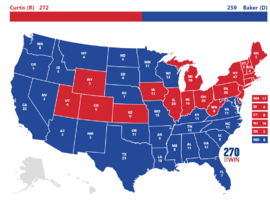1932 United States presidential election (ARC)
| |||||||||||||||||||||||||||||
All 531 electoral votes of the Electoral College 266 electoral votes needed to win | |||||||||||||||||||||||||||||
|---|---|---|---|---|---|---|---|---|---|---|---|---|---|---|---|---|---|---|---|---|---|---|---|---|---|---|---|---|---|
| Opinion polls | |||||||||||||||||||||||||||||
| Turnout | 53.2% | ||||||||||||||||||||||||||||
| |||||||||||||||||||||||||||||
 Presidential election results map. red denotes states won by Curtis/France, and Blue denotes those won by Baker/Ritchie. Numbers indicate the number of electoral votes allotted to each state. | |||||||||||||||||||||||||||||
| |||||||||||||||||||||||||||||
The 1932 United States presidential election was the 37th quadrennial presidential election, held on Tuesday, November 8, 1932. Taking place against the backdrop of the Great Depression, Vice President Charles Curtis successfully defeated his Democratic opponent, former United States Secretary of War, Newton Baker.
As a result of disastrous economic conditions caused by the Great Depression, incumbent President Herbert Hoover, despite facing little opposition in the Republican Party, chose not to run for a second term as president, allowing his deputy, Vice President Charles Curtis to run as the Republican candidate instead. Meanwhile, on the Democratic side, Governor Franklin D. Roosevelt of New York, initially a leading candidate for the party nomination, was defeated by former United States Secretary of War, Newton Baker, who had managed to unite a vast number of different factions within the party, while promising to bring an end the Great Depression.
Baker, who initially led with a near-landslide majority, saw his lead gradually erode as Curtis, in a break from his boss's previous policies, promised interventionist and largely popular measures meant to tackle the ongoing economic crisis. On Election Day, Curtis swept most of the states in the North and also picked up a number of states in the Midwest, allowing him to secure a narrow victory with 272 electoral votes to Baker's 259, in what was considered one of the greatest upsets in American political history.
Most significantly, this election marks the first and only time of Charles Curtis's presidential run, as he would later pass away on February 8, 1936, just nine months short of the subsequent 1936 presidential election, which his vice-president, Joseph I. France, contested and won, before also later dying in office in 1939, unable to contest the following 1940 presidential election.

